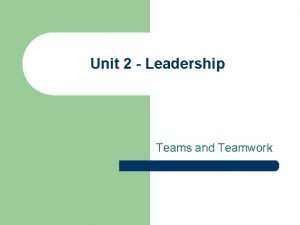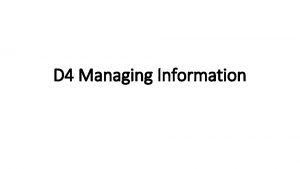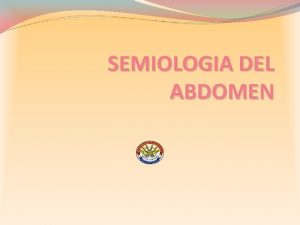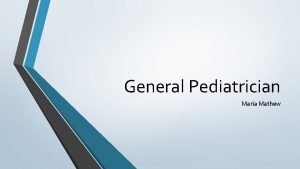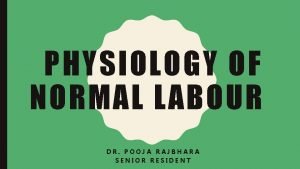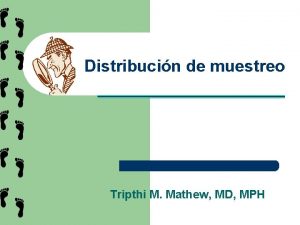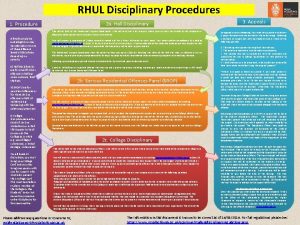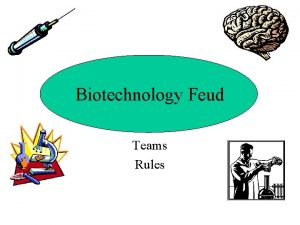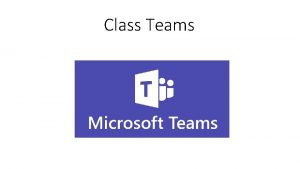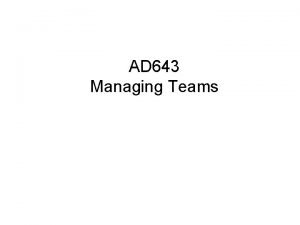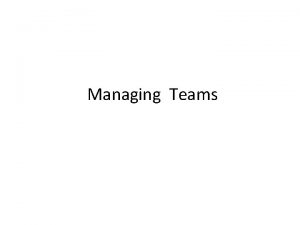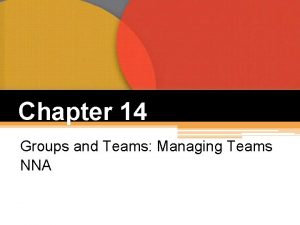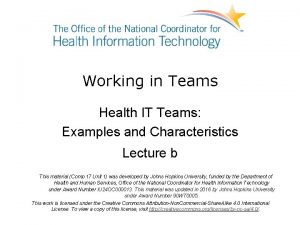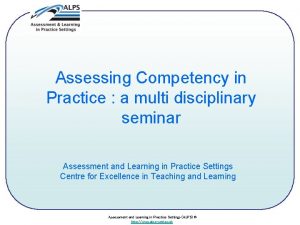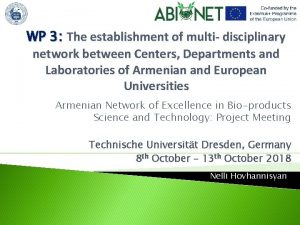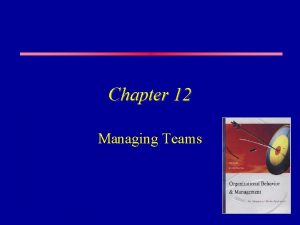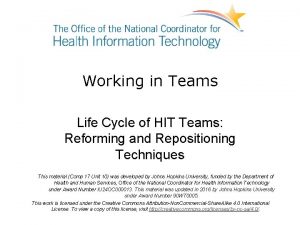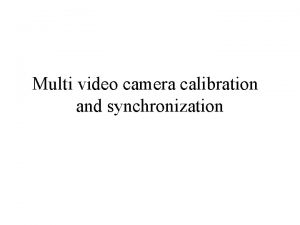Managing and Working in Multi Disciplinary Teams Mathew





































- Slides: 37

Managing and Working in Multi Disciplinary Teams Mathew Roosa & Carolyn Castro-Donlan

Managing and Working in Multi Disciplinary Teams: Walking the walk of effective team work By the end of this webinar you will: 1. Understand the key concepts and values of teams. 2. Be familiar with clinical practice models with MDTs. 3. Learn how to use key tools to promote team work.

Managing and Working in Multi Disciplinary Teams: Walking the walk of effective team work Concepts and values of teams • Teams= more than one • Teams= diversity

Managing and Working in Multi Disciplinary Teams: Walking the walk of effective team work Concepts and values of teams • Teams= more than one • Teams= diversity

If you want to go fast, go alone.

If you want to go far go together. African Proverb

Core Belief: • Groups are more capable than individuals 7

Managing and Working in Multi Disciplinary Teams: Walking the walk of effective team work Concepts and values of teams • Teams= more than one • Teams= diversity

MDT defines • A group composed of members with varied but complimentary experience, qualifications, and skills that contribute to the achievement of the organization's specific objectives www. businessdictionary. com • Experience (personal (diversity) and professional) • Qualifications (credentials) • Skills (specialization)

Diverse Team Interdisciplinary & Diverse teams create learning organizations Learning thru Team Action vs. Mandated doing

• See description word doc.


Managing and Working in Multi Disciplinary Teams: Walking the walk of effective team work Clinical practice models with MDTs • Define multidisciplinary and interdisciplinary teams • Clinical practice models – components and examples • Benefits and disadvantages

Managing and Working in Multi Disciplinary Teams: Walking the walk of effective team work Clinical practice models with MDTs • Define multidisciplinary and interdisciplinary teams • Clinical practice models – components and examples • Benefits

Multidisciplinary Interdisciplinary Work in a Team Engage in Teamwork team member uses his or her own expertise to develop individual care goals team build on each other’s expertise to achieve common, shared goals Alignment with a common care/ treatment plan Integrated Care/treatment plan

THE IMPORTANCE OF COLLABORATION

Managing and Working in Multi Disciplinary Teams: Walking the walk of effective team work Clinical practice models with MDTs • Define multidisciplinary and interdisciplinary teams • Clinical practice models – components and examples • Benefits and disadvantages

Teaching Hospital and Medical Health Care Systems

Challenges in Addressing Complex Needs Education and Vocational Resources Overall Aims: • Improve clinical outcomes • Improve communication and coordination of communication between professionals, individuals, their supports, caregivers and coordination throughout the treatment episodes, aftercare and recovery support. • Facilitate service planning and coordination across the institutional boundaries • Build efficiencies and streamline the treatment and referral process and thereby reduces undesirable delay in treatment or aftercare supports. Trauma/ Intimate Partner Violence Criminal Justice and Legal issues Poverty and Unemployment Co-occurring medical and mental health Concerns Generational Substance use disorders

Critical Partners • Child Welfare Home Visiting • Criminal Justice Faith-based Organizations • Employment Programs Housing • Mental Health Education Colleges and Universities Domestic Violence Providers Credit Counseling Agencies Advocacy Organizations • Health • Welfare/TANF • Early Intervention/Child Development

Holistic Care Coordination Gender Responsive Trauma Informed Family Centered Person Centered Developmentally Culturally Responsive Tailored Care Coordination

Establish Structure • Have a leader - convener • Guidance – establish policies and procedures • Regular meetings and case conferences • Set the expectation: • Share expertise, working knowledge, skills and resources • Care coordination and communication This Photo by Unknown Author is licensed under CC BY-NC-ND

How to work in multi-disciplinary teams 1. Define roles and boundaries 2. Be aware of power dynamics 3. Taking decisions 4. Different professionals have different views 5. Input from service users

Managing and Working in Multi Disciplinary Teams: Walking the walk of effective team work Clinical practice models with MDTs • Clinical practice of multidisciplinary and interdisciplinary teams • Clinical practice models – components and examples • Benefits and disadvantages

Benefits of MDT: Just some advantages • Better outcomes and care for client • Improved decision making • Improved cross discipline coordination and communication • Client options • Improved continuity of care • Holistic approach • Committed team sharing values and goals • Diverse experience and shared learning opportunities • Increased access to information, support and resources • Mutual accountability

Disadvantages of MDT: Some not so good things • • Time and resource dependent No meetings or information sharing Lack of continuity and access to services Client needs not met – poor outcomes Some team members dominate Communication challenges Challenges with client confidentiality Delay in decisions and process

IMPROVING OUTCOMES This Photo by Unknown Author is licensed under CC BY-SA

Managing and Working in Multi Disciplinary Teams: Walking the walk of effective team work Key tools to promote team work • Team as Verb • Walking the Talk with Tools

MDTs are Awesome!

Team as Verb “To Team…the act of Teaming…” … 30 “To put together in order to do something or to achieve a particular effect. ”

The Act of Teaming in a Learning Collaborative: Take Action with Process Tools 1. Nominal Group Technique 2. Cause and Effect Diagram 3. Rapid Cycle PDSA 4. Environmental Scan 5. Swot/Soar Analysis 6. Walk Through 7. Flow Chart 8. Surveys 31 Practice is Everything - Pele

Good Nominal Group Technique Brainstorming is… • Structured/Facilitated by a leader. • Focused on a specific question or problem. • Includes all participants. • Encourages all ideas. • Engages individuals in a team effort. • Generates a wide range of new ideas. 32

Nominal Group Technique Four Steps of NGT 1. Silent generation of ideas based on a strong question. 2. Round robin report out and record. 3. Discussion for clarification. 4. Voting. (Forced Choice) 33

Cause and Effect Diagram • Finding the Root Cause: What causes these obstacles? C C C Problem C 34 C C C Why does that happen?

Criteria for Review of Root Causes What is Attainable and What Will Have High Impact? Avoid this! High Difficulty, Low Impact High Difficulty, High Impact Low Difficulty, Low Impact Low Difficulty, High Impact 35 Do this!


of TEAMS Thank You! Managing and Working in Multi Disciplinary Teams Mathew Roosa & Carolyn Castro-Donlan June 5, 2018
 Understanding work teams
Understanding work teams Leading and working in teams
Leading and working in teams Reflexivity definition
Reflexivity definition Brianmac poms
Brianmac poms Disciplinary knowledge
Disciplinary knowledge Powerful disciplinary knowledge
Powerful disciplinary knowledge Disciplinary literacy in physical education
Disciplinary literacy in physical education Kentucky board of nursing disciplinary actions
Kentucky board of nursing disciplinary actions Frisk disciplinary
Frisk disciplinary University of texas at arlington library
University of texas at arlington library Leadership and teamwork in the public services
Leadership and teamwork in the public services Benne and sheats group roles
Benne and sheats group roles Hot working and cold working difference
Hot working and cold working difference Hot and cold forming
Hot and cold forming Machining operations
Machining operations Proses hot working
Proses hot working Multi channel multi phase example
Multi channel multi phase example Multi loop pid controller regolatore pid multi loop
Multi loop pid controller regolatore pid multi loop Working practices for managing information
Working practices for managing information Working smart vs working hard
Working smart vs working hard Mathew 6:26
Mathew 6:26 Modern data architecture consultant
Modern data architecture consultant Maniobra de enganche
Maniobra de enganche Matt 10:12
Matt 10:12 Mathews v eldridge test
Mathews v eldridge test Greek hacker astra
Greek hacker astra Pediatrician job description
Pediatrician job description Mathew 24:44
Mathew 24:44 Mathew 6:7-15
Mathew 6:7-15 Living ligature of uterus meaning
Living ligature of uterus meaning Matthew chp 5
Matthew chp 5 Jose manuel mathew
Jose manuel mathew Asher mathew
Asher mathew Mathew williams md
Mathew williams md Mathew 2:1-12
Mathew 2:1-12 Matthew chapter 8
Matthew chapter 8 Mathew 6
Mathew 6 Matthew 12:36 commentary
Matthew 12:36 commentary











